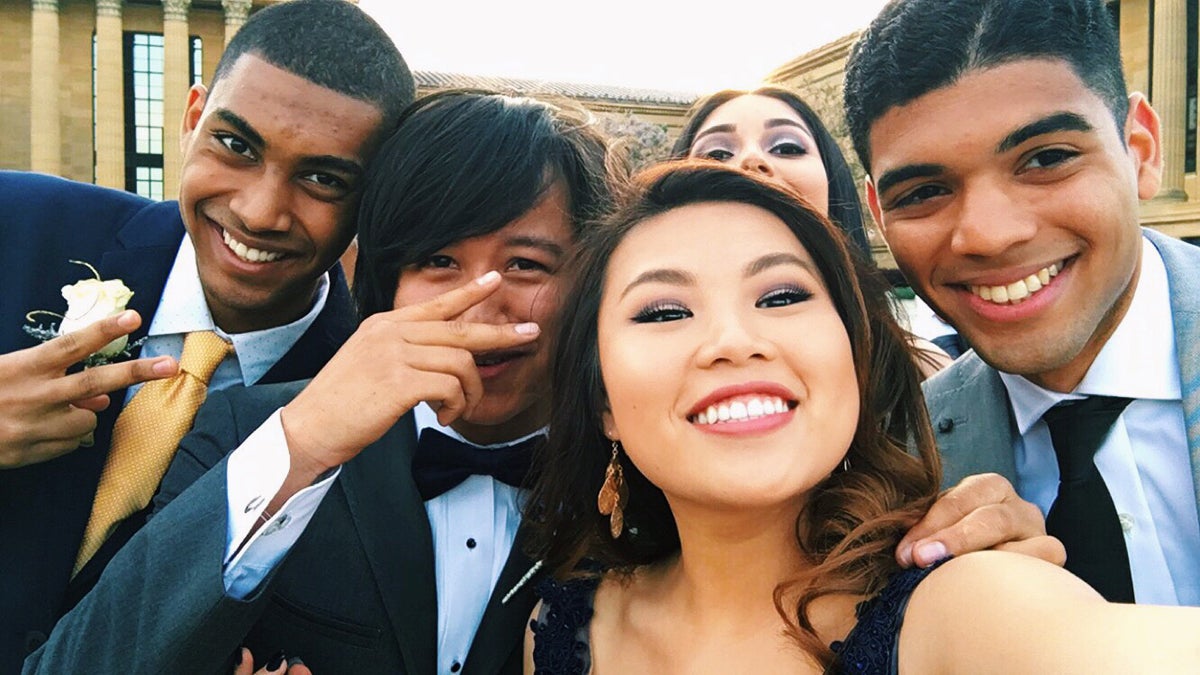When the imaginary audience becomes more real
Listen 10:04
Amanda imagines her friends, family members, strangers - they are all looking at her pictures and judging her. Part of that is because of a concept in psychology called "The Imaginary Audience."
There’s a scene that is frozen in my memory, and that pops into my head often. I am not sure why.
I’m 16 years old, and I’m meeting a friend at a cafe. The cafe has big windows and as I get off my bike, I can see people sitting at tables, chatting, drinking coffee.
I’m locking up my bike, and I feel everybody staring at me. Everybody at the cafe is paying attention to what I’m doing. I’m praying I won’t drop my bike lock, or my keys.
I walk toward the cafe’s glass door, and the whole time I’m thinking, ‘is this a push or pull door. What if I pull and it’s really push?’ I’m feeling panicked over the possibility of making a fool of myself.
This notion of being watched and judged remained present throughout my adolescence — and it’s a feeling Philadelphia high school senior Amanda Thieu is very familiar with.
When she’s in school, she plans her every move. “Let’s say my seat is across the room, I would have to move this way in order to get to my seat without getting noticed as much.”
She’s scared of stumbling. Pushing on a pull door. Being judged.
“I feel like they would judge me on my body mostly, or, ‘who does she think she is walking in the room like that?’ or, ‘wow, what is she wearing today?'”
Eleven year old Helena Savin is worried about saying something stupid in school, because mistakes will not be forgotten.
“I feel like whatever I’m going to say is going to be on everyone’s mind, all the time,” she said.
Her friend Sanai Miller agrees – she’s terrified of embarrassing herself, and is cautious about everything she does to avoid gaffes. She also has a lisp and says it makes her worried that she’ll mispronounce a word.
This feeling and state of being has a name. In psychology, it’s called The Imaginary Audience.
“There are others out there, unseen others who are thinking about us, and judging us at all times,” explained Drew Cingel, an assistant professor of communication at the University of California, Davis. “It is a developmental variable and it is heightened during adolescence. Because adolescents are somewhat egocentric, so they think that people are thinking about them and judging them at all times.”
Think about a time when you were a teen and you hated your off-brand sneakers. Your shirt was too bright. Your new haircut too new.
“If you have a stain on your pants, and you go to school , all day you will be thinking that everybody out there in school notices the spot on your pants,” said Cingel. “Everybody is judging you because you came to school with a spot on your pants.”
Naming the unseen judges
The man who coined the term “imaginary audience” in the late sixties is David Elkind, a child psychologist and professor emeritus at Tufts University. As a young man, he spent many years working in family courts – and noticed that kids who got in trouble were often trying to impress a perceived audience of people paying attention to their every move. He began to study this and found that the notion that others were watching was tied to kids’ emotional development.
“When adolescents get their new abilities, they are able to think about thinking, it’s a second age of reason if you will. And one of the capacities they have now is to think about other people’s thinking.”
Adolescents are going through rapid changes – with their bodies, emotions, roles in the world – and they think a lot about themselves during that time period. When they wonder about what others are thinking – they return to themselves, and come to the conclusion – ‘they must be thinking what I’m thinking – about me!’
The imaginary audience tends to be stronger in kids with lower self-esteem, and also in girls. It weakens after adolescence, but stays with most of us through adulthood – Elkind is in his 80s now, and still feels it pop up every once in awhile.
“Sometimes when I’m on the road and I drop a fork and it clinks, and I think everybody is watching me and thinking I’m a klutz,” he said with a chuckle. “Whenever we are in a new social situation, we become especially aware of the audience and how they are thinking of us.”
Back in the sixties and seventies, Elkind studied his observations, and developed scales to measure the imaginary audience, but had trouble getting his work published at first. Once it was finally published, it became widely read and spawned a solid body of follow-up research.
Imaginary Audience 2.0
Drew Cingel at UC Davis is one of the researchers building on Elkind’s work – and has studied how the concept of the imaginary audience has changed in our social media world.
“Social media is a space where there is an imaginary audience, we are crafting communication for someone, we’re not sure whom at any given time,” he said.
Of course the social media audience is real – but only to an extent. You could imagine you are posting for all of your followers and friends, when really only a few of them actually see what you wrote.
“Who is out there, who will receive this message, and you’re thinking about how to put yourself in the best light that you’d want to be in.”
Cingel did a recent series of tests with kids between the ages of 12 and 18, and checked how prevalent their imaginary audience was. He asked them a series of questions.
“How often you think of being a rock star, or how often you think of people coming to your funeral.”
He also tested how often they posted on social media, changed their pictures, checked into places and so on.
He found that there was a relationship between social media use and thinking about the imaginary audience – it’s a bit of a chicken and egg question but – the more kids used social media the more they thought about their imaginary audience.
For high school senior Amanda Thieu, social media has added another level of stress, more worry about being judged. It’s the imaginary audience on steroids – because it’s potentially so much bigger than her high school audience.
Like all “normal” teenage girls – as she puts it – she posts a lot of selfies. But it’s not as easy as snapping a picture and putting it online.
“So I would take a lot, 20 in a couple of minutes with different poses, I would edit them and then I would pick my top five to send to my best friends, which one they think I should post.”
Amanda imagines her friends, family members, strangers – they are all looking at her pictures and judging her. “How many likes I get on this picture would determine if I’m pretty or not, and like ‘whoa, I’m popular because I have 200 likes.'”
Drew Cingel wants to explore how social media use actually impacts and changes adolescent development – he says right now there’s a lot of emphasis on understanding what kids are doing online – but not so much investigation of how it is changing them – and all of us.
Amanda says sometimes, she longs for the days before her audience showed up.
“Like maybe kindergarten, and I would have walked into school and people would greet me and I would think, ‘okay, cool, let me go play now.'”
In recent weeks, she has taken a bit of a break from social media, and says it has allowed her to focus on bigger things, like her college applications.
WHYY is your source for fact-based, in-depth journalism and information. As a nonprofit organization, we rely on financial support from readers like you. Please give today.




